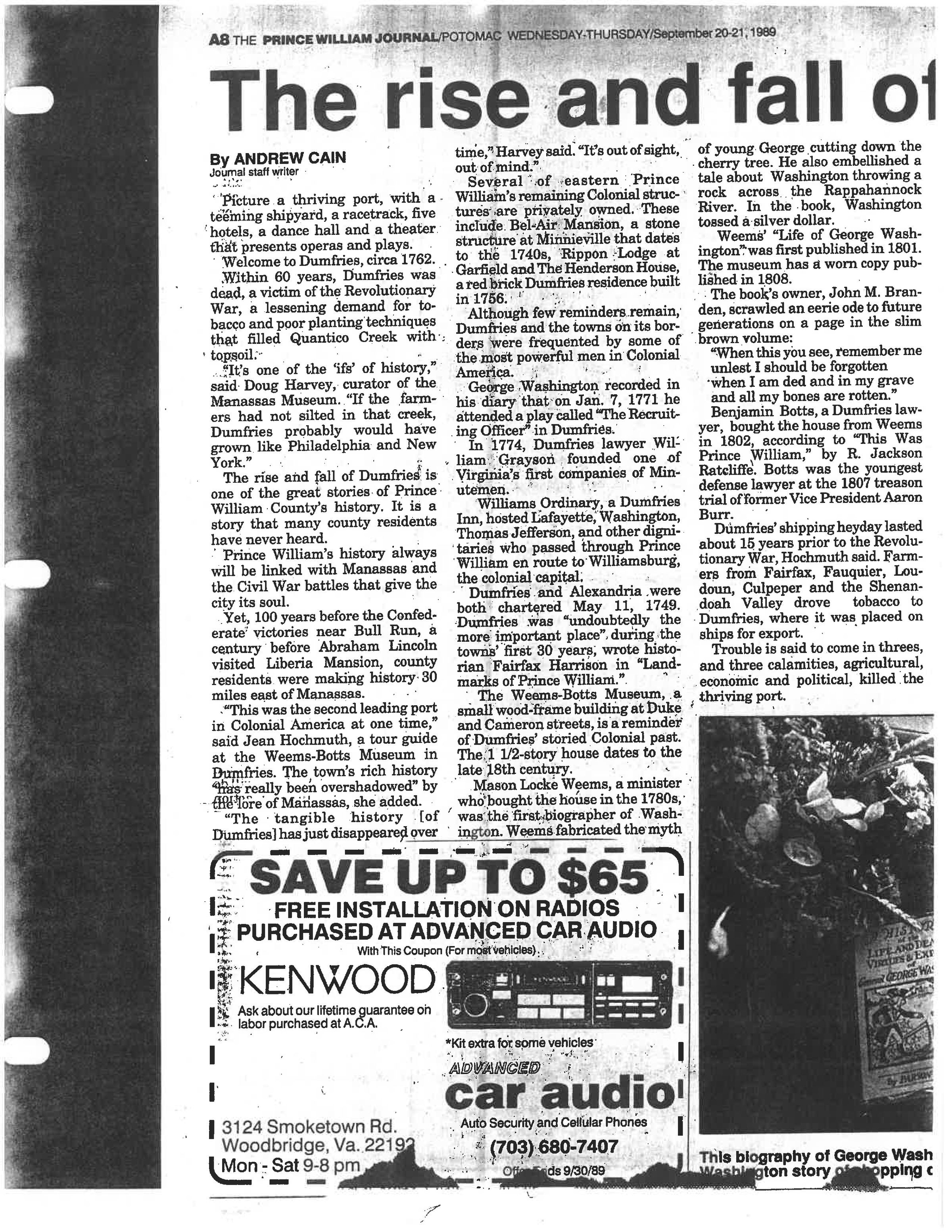Transcription
A8 THE PRINCE WILLIAM/POTOMAC WEDNESDAY-THURSDAY/September 20-21, 1989
The rise and fall of Old Dumfries
By Andrew Cain
Journal staff writer
Picture a thriving port, with a
teeming shipyard, a racetrack, five
hotels, a dance hall and a theater
that presents opera and plays.
Welcome to Dumfries, circa 1762
Within 60 years, Dumfries was
dead, a victim of the Revolutionary
War, a lessening demand for tobacco
and poor planting techniques
that filled Quantico Creek with
topsoil.
"It's one of the 'ifs' of history,"
said Doug Harvey, curator of the
Manassas Museum. "If the farmers
had not silted in that creek,
Dumfries probably would have
grown like Philadelphia and New
York."
The rise and fall of Dumfries is
one of the great stories of Prince
William County's history. It is a
story that many county residents
have never heard.
Prince William's history always
will be linked with Manassas and
the Civil War battles that give the
city its soul.
Yet, 100 years before the Confederate
victories near Bull Run, a
century before Abraham Lincoln
visited Liberia Mansion, county
residents were making history 30
miles east of Manassas.
"This was the second leading port
in Colonial America at one time,"
said Jean Hochmuth, a tour guide
at the Weems-Botts Museum in
Dumfries. The town's rich history
"This really been overshadowed" by
the lore of Manassas, she added.
"The tangible history [of
Dumfries] has just disappeared over
time," Harvey said. "It's out of sight,
out of mind."
Several of eastern Prince
William's remaining Colonial structures
are privately owned. These
include Bel-Air Mansion, a stone
structure at Minnieville that dates
to the 1740s, Rippon Lodge at
Garfield and The Henderson House,
a red brick Dumfries residence built
in 1756.
Although few reminders remain,
Dumfries and the towns on its borders
were frequented by some of
the most powerful men in Colonial
America.
George Washington recorded in
his diary that on Jan. 7, 1771 he
attended a play called "The Recruiting
Officer" in Dumfries.
In 1774, Dumfries lawyer William
Grayson founded one of
Virginia's first companies of Minutemen.
Williams Ordinary, a Dumfries
Inn, hosted Lafayette, Washington,
Thomas Jefferson, and other dignitaries
who passed through Prince
William en route to Williamsburg,
the colonial capital.
Dumfries and Alexandria were
both chartered May 11, 1749.
Dumfries was "undoubtedly the
more important place" during the
towns' first 30 years, wrote historian
Fairfax Harrison in "Landmarks
of Prince William."
The Weems-Botts Museum, a
small wood-frame building at Duke
and Cameron streets, is a reminder
of Dumfries' storied Colonial past.
The 1 1/2-story house dates to the
late 18th century.
Mason Locke Weems, a minister
who bought the house in the 1780s,
was the first biographer of Washington.
Weems fabricated the myth
of young George cutting down the
cherry tree. He also embellished a
tale about Washington throwing a
rock across the Rappahannock
River. In the book, Washington
tossed a silver dollar.
Weems' "Life of George Washington"
was first published in 1801.
The museum has a worn copy published
in 1808.
The book's owner, John M. Branden,
scrawled an eerie ode to future
generations on a page in the slim
brown volume:
"When this you see, remember me
unlest I should be forgotten
when I am ded and in my grave
and all my bones are rotten."
Benjamin Botts, a Dumfries lawyer,
bought the house from Weems
in 1802, according to "This Was
Prince William," by R. Jackson
Ratcliffe. Botts was the youngest
defense lawyer at the 1807 treason
trial of former Vice President Aaron
Burr.
Dumfries' shipping heyday lasted
about 15 years prior to the Revolutionary
War, Hochmuth said. Farmers
from Fairfax, Fauquier, Loudoun,
Culpeper and the Shenandoah
Valley drove tobacco to
Dumfries, where it was placed on
ships for export.
Trouble is said to come in threes,
and three calamities, agricultural,
economic and political, killed the
thriving port.
Farmers overplanted their tobacco
crops and the topsoil washed
into the creek. Ocean-going ships
could no longer ply the waters that
led to the wharves at Dumfries.
At the same time, the tobacco
trade waned as interest grew in
other commodities like wheat and
sugar. Alexandria flourished by
converting to flour. Dumfries failed
to adapt.
Merchants of Dumfries, Scotland
who bought much of the tobacco
loaded at the port, were thwarted
by the Revolution and ordered sugar
from the West Indies instead, Harrison
wrote in "Landmarks of Prince
William."
By the 1820s, Dumfries was a
ghost town, Harvey said. Harrison
quoted a letter from a bishop who
visited Dumfries in 1819.
"Once the mart, the scene of gayety
and fashion, the abode of
wealthy merchants, all is now in
ruins."
Dumfries was mostly dormant
until the late 1800s, when mining
brought the area renewed prosperity.
Sitting in the Weems-Botts Museum
recently, Hochmuth glanced
at the narrow wooden stairwell and
gray-brown floorboards that have
withstood 200 years of Dumfries
history.
"It's too bad they couldn't talk,"
she said.
SAVE UP TO $65
FREE INSTALLATION ON RADIOS
PURCHASED AT ADVANCED CAR AUDIO
With This Coupon (For most vechiles)
KENWOOD
Ask about our lifetime guarantee on
labor purchased at A.C.A.
*Kit extra for some vechiles
ADVANCED
car audio
Auto Security and Cellular Phones
(703) 680-7407
Office[Feds] 9/30/89
3124 Smoketown Rd.
Woodbridge, Va. 22192
Mon - Sat 9-8 pmTranscriber
Adam KitchenLanguage
English
